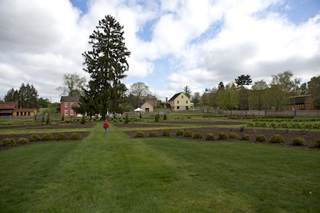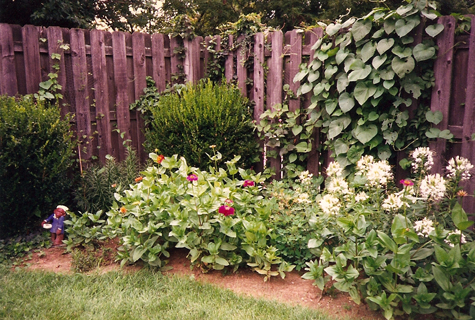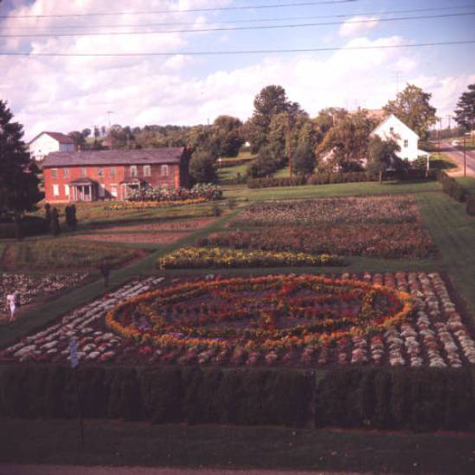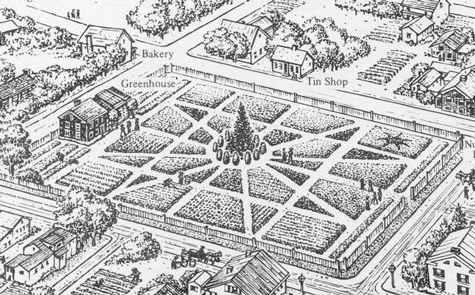Human Flower Project
Conceptual Gardening
With design, aesthetics and ecological concerns leading the way, symbolism isn’t much of a force in contemporary gardening. But we offer two examples where concept dominates, one noble, the other daffy.

The Zoar garden with its symbolic spruce at the center.
Our first stab at a garden, on High St. in Lexington, Kentucky, was as conceptually ambitious as it was horticulturally shaky. (Aesthetics/design? What are those?)
In a squarish back yard surrounded by a high (inherited) fence, we planned an astrological garden, sectioning the perimeter into 12 beds and designating each to a zodiacal sign, Aries to the East, Cancer to the North, Libra toward the West, and Capricorn on the South. Then we went about finding plants and objects that corresponded to each sign.
Windflowers? In Gemini of course. Zinnias for Leo. A vine of moonflowers under Cancer, etc. At a flea market we came upon a very strange plaster statue: a monkey in a blue nurse’s uniform holding a bedpan. Perfect for Virgo!
The astrological garden on High St., Lexington, KY: Leo zinnias and Virgo orderly.
Photo: Human Flower Project
On the evening of the summer solstice, 1997, we invited about thirty friends over and had them stand around the edges of the yard at their proper astrological stations, and beginning with Mimi Pickering (born closest to the spring equinox and thus the “firstborn” of the zodiacal year), each guest announced his or her birthdate as well as a “fairy name.”
After we’d all come full around the year, ending with Edward Roberts, born March 17, we planted a redbud tree in the center of the yard, watered by Nina McCormack and Marty Newell, the two Aquarians present.
This very contrived endeavor came to mind recently as we read about a far more serious conceptual garden at the Village of Zoar, Ohio, a town of German Separatists that, some claim, had the first communal society of any European immigrants to the U.S.
The Village of Zoar was named this year as one of the most endangered historical places by the National Trust for Historic Preservation. The entire town—including its garden—may be flooded if the Army Corps of Engineers decides not to rebuild a crumbling levee on the Tuscarawas River.

Zoar Garden circa 1960
Photo: Columbus Dispatch
The original settlers came to the U.S. in 1817 to escape religious persecution in their homeland. As a reflection of both their faith and their belief in a communal society, the villagers constructed in the center of town a large garden, designed after the book of Revelation, Chapter 21.
James Griffing, a 19th century visitor, wrote: “In the center of the garden stood a Norway spruce representing everlasting life, and around the tree was an arbor vitae hedge symbolizing heaven; This in turn was surrounded by twelve juniper trees; one for each of the apostles… A circular walk enclosed the centrum, and from this twelve other walks representing various paths to heaven radiated to the four sides of the garden. These in turn were intersected by walks which symbolized the worldly ways through which people wander on earth before they find salvation.”
How enlightened to recognize that many paths lead to heaven.

Drawing of the Zoar Garden with its radiating path and central spruce, representing Christ.
A more contemporary and horticulturally-minded historian writes, “Although some vegetables and fruits were grown here, the garden was filled mainly with flowers.” Is there a plant list anywhere? We haven’t found one, but as a former “conceptual gardener” (though a pagan one), we feel certain that as with our Gemini windflowers, the plants the Zoar gardeners chose symbolized some tie to their aspiration and greater design – the New Jerusalem.

